Introduction
I suppose that among artists and people of any artistic appreciation, it is generally admitted by this time that the greatest bulk of the works of “Phiz,” Cruikshank, Doyle, and even many of Leech’s designs are simply rubbish, and that the reputation of these men was made by critics whose names and works are absolutely forgotten, or else, by Thackeray, Dickens, and Tom Taylor, whose books they illustrated and who had absolutely no intelligent knowledge of art, their one idea being to log-roll their friends and illustrators. — Joseph Pennell, Modern Illustration (1895)
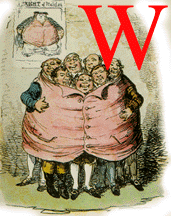
riting at the end of the long nineteenth century, author and artist Joseph Pennell blatantly dismissed the accomplishments of the leading caricaturists whose work commanded mass audiences in the 1830s and 1840s. Pennell is one of several pioneering critics of the Victorian illustrated book who trashed what is often referred to as the “Cruikshank-Phiz era” (Jackson 12) in his zeal to praise the realist artists who entered the lucrative market of book illustration in the 1850s. Gleeson White and Forrest Reid in, respectively, Illustration, the Sixties’: 1855-70 (1897) and Illustrators of the Eighteen Sixties (1928) similarly panned the caricaturists for a style that was best suited for “broad farce” and was “slipshod” (White 18) at best. The caricature school of illustration derives from a style that originated three centuries earlier at the Carracci Academy in Bologna, Italy. Sixteenth-century Italian artist brothers Annibale and Agustino Carraci, for recreation, created small loaded portraits called caricature heads to capture a likeness between a sitter and an inanimate object or animal. In the late eighteenth century, the term “caricature”—which derives from the Italian word “caricare,” meaning “to overload” or “surcharge”—came to be applied to comic prints by the heirs of leading eighteenth-century satirist William Hogarth — James Gillray, Thomas Rowlandson, and George Cruikshank (who earned a reputation for his comic plates before he became a book illustrator). Noting similarities between sixteenth-century mock portraits and early nineteenth-century satiric illustration in Caricature, E.H. Gombrich and E. Kris advance: “Aims and means were the same in both types—to ridicule and castigate by means of light-hearted playful distortion” (19). Was it this playful exaggeration to the point of ridicule that led Pennell and other fans of the realistic school of illustration to stereotype the achievement of the caricaturists?
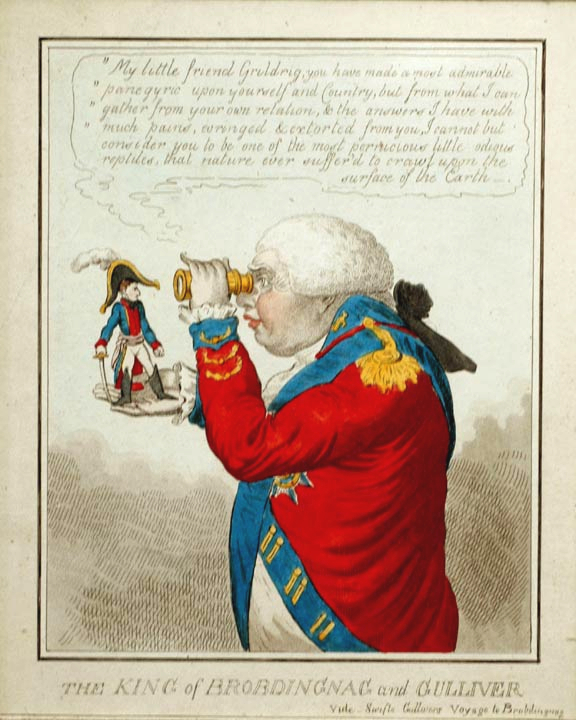
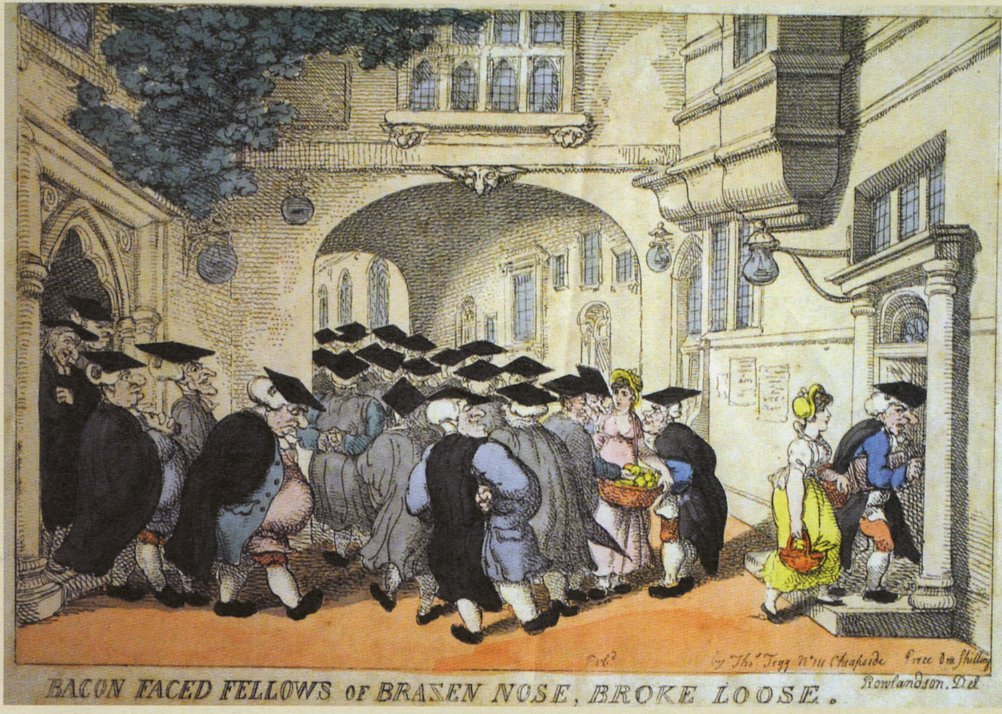


Left: The King of Brobdingnag and Gulliver by James Gillray. Middle left: Bacon Faced Fellows of Brazen Nose, Broke Loose by Thomas Rowlandson. Middle right: Social zoology by George Cruikshank. Right: King George IV as the Prince of Wales by George Cruikshank. [Click on images to enlarge them.]
Artistic taste changed in in the 1850s. The Victorian public increasingly preferred the work of Academy-trained artists including John Everett Millais, George Du Maurier, Frederick Sandys, and Marcus Stone. Sometimes referred to as “the Millais era” (Jackson 12), the school of representational realism brought naturalism and beauty to book illustration during the “Sixties” (a period that ran from the mid 1850s through the mid 1870s). But Pennell, in his sweeping assessment of the leading nineteenth-century caricaturists, is overly harsh and misleading. Caricature-style illustrations designed during the 1830s and 1840s were arguably more important than the texts they accompanied in serials published in monthlies and weeklies, a thriving form of mass-market literature. For example, young Dickens was asked by publisher Edward Chapman and William Hall to “write up to” the illustrations of Robert Seymour, a popular early-nineteenth century caricaturist, for the work that came to be called The Posthumous Papers of the Pickwick Club (1837). Cruikshank’s caricature-style illustrations drew a large readership to William Harrison Ainsworth’s Jack Sheppard (1839) as well as Charles Dickens’s Oliver Twist (1838). Henry James even recollects in his autobiographical work entitled A Small Boy and Others (1914) that Oliver Twist “perhaps even seemed to me more Cruikshank’s than Dickens’s” (120).
The caricaturists have been revaluated, but their work still demands wider appreciation, leading me to make two claims. The caricature style, in vogue in the 1820s through the 1840s, is foremost theatrical. It can be expressive and powerful as well as humorous and even grotesque in its penchant for distortion. Secondly, even as the illustrated book evolved, and the public came to favor book illustration that simulated the lifelike quality of the emerging art of photography, caricature retained influence through Punch, the standard humor magazine; reissued books illustrated by Browne, Cruikshank, and Leech among others; the Household Edition of Dickens’s works published in the 1870s wherein Sixties artists essentially refashioned the caricature-style illustrations that brought Dickens fame; and reengagement of caricature techniques by artists in the 1860s – 1890s, most notably George Du Maurier. A recognized Sixties artist, Du Maurier not only championed the work of the caricaturists at the fin de siècle, but he also used aspects of caricature in Trilby (1894), a major publishing sensation on both sides of the Atlantic.
A Theatrical Style
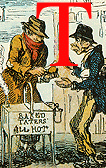
he caricaturists used lighting, cuing, props, backdrops, and staging to capture dramatic and sentimental scenes in works by Dickens, Ainsworth, and William Makepeace Thackeray as well as to stage psychological episodes and broadly comic moments. In its theatricality, caricature-style book illustration approximates a style of performance that predates the nineteenth century but is closely associated with early nineteenth-century drama—the dramatic tableau. Defined inclusively, “tableau vivant, or ‘living picture,’ refers to the representation of some well-known person, scene, or incident, whether taken from a verbal or visual source, by a performer or performers who, appropriately attired and positioned, hold their poses silently and motionlessly” (J. E. Hill 438). In the nineteenth century, charades, private theatricals, and tableaux vivants were enormously popular forms of entertainment in private homes among members of the upper middle class and the gentry. In the 1830s when Cruikshank was illustrating serials by Dickens and Ainsworth, the theatre, once considered disreputable, began to draw middle-class audiences. During this period, Dickens’s and Ainsworth’s popular serials were quickly being translated into plays even before the serials were completed. The dramatic adaptations of Jack Sheppard and Oliver Twist, in turn, attracted more reader-viewers to these very same illustrated serials whose plates were theatrical in design.
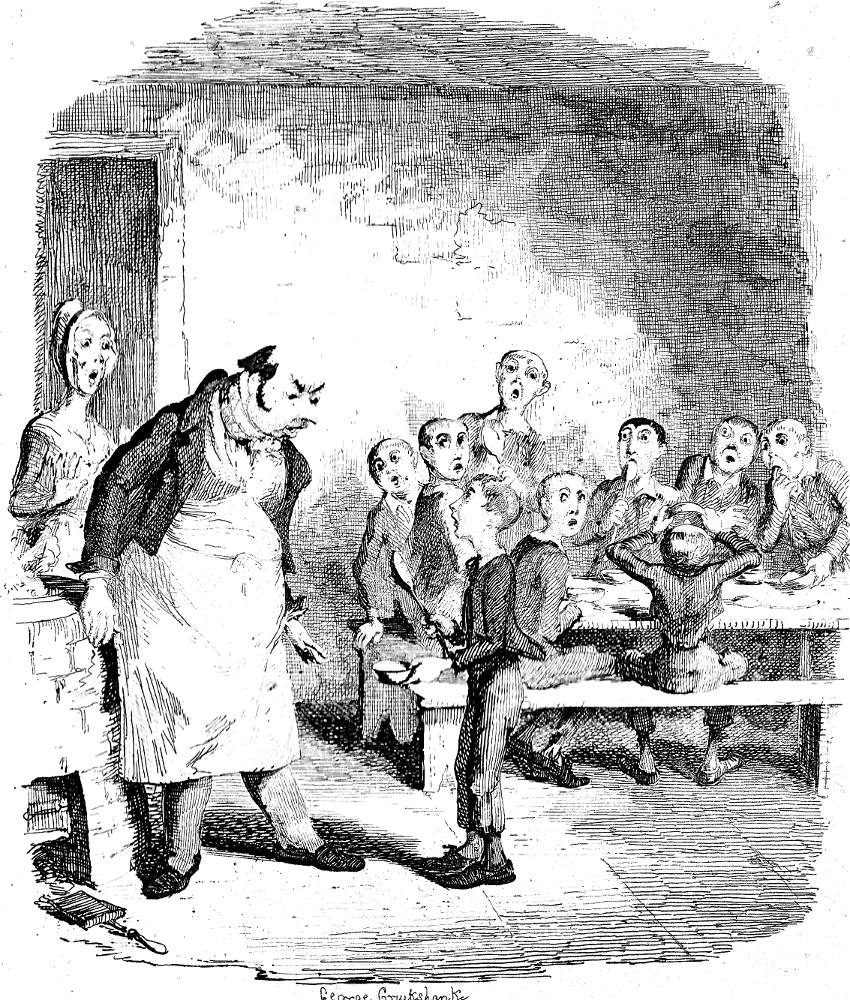
Cruikshank’s Oliver Asking for More. Click on image to enlarge it.
Oliver Asking for More, one of Cruikshank’s most famous plates, approximates a tableau vivant and quintessentially demonstrates several dramatic techniques that distinguish the best work of the caricaturists—staging, lighting, expressive gestures, and props. Cruikshank depicts the moment where starving orphan Oliver, a victim of the cruel workhouse system, daringly requests more than his meager dietary allotment: “‘Please, sir, I want some more’” (OT 10). The pivotal moment of asking for more gruel gets lost in the narrative commotion that follows—the master strikes a blow at Oliver, pinions his arms, and calls for Mr. Bumble, the parish beadle, who, in turn, reports Oliver’s infamy to the board; Oliver is immediately ordered into confinement, and the next day the parish, eager to rid itself of the upstart, posts a notice that for 5 pounds, anyone can take him off the parish’s hands. The narrative moves swiftly beyond this climactic moment that Cruikshank powerfully freezes in an expressive plate that is caricature at its best.
Using a spotlight dramatically in this plate, Cruikshank illuminates the emaciation of the workhouse children: the hollow-eyed, sunken-cheeked orphans form a dramatic backdrop to magnify Oliver’s plight. The inhumane workhouse system keeps the orphans in a state of near starvation:
The bowls never wanted washing. The boys polished them with their spoons till they shone again; and when they had performed this operation, (which never took very long, the spoons being nearly as large as the bowls,) they would sit staring at the copper, with such eager eyes, as if they could have devoured the bricks of which it was composed; employing themselves, meanwhile, in sucking their fingers most assiduously, with the view of catching up any stray splashes of gruel that might have been cast thereon. [OT 10]
Cruikshank uses props—large spoons and tiny bowls—to emphasize the insufficiency of the parish dietary allotment. Cruikshank also uses the caricature technique of comic comparison to stage the scene to dramatic effect. Oliver, positioned in profile, assumes little space while the big-bellied master in cook’s uniform dominates the plate through his girth and three-quarter stance. The master’s tight white apron strains across his waist, indicating that the master—unlike Oliver and the other starving inmates—has no need to ask “for more.” Through these caricature techniques, Cruikshank makes an appeal for much needed reform of the parish workhouse system. Not surprisingly, this plate even caught the attention of Queen Victoria, who mentions it in an 1839 diary entry (Victoria 44).

Ignorance and Want by John Leech.
Approximating stage sets, the backdrops of caricature-style illustrations move the reader-viewer from the parish workhouse to Newgate Prison in Oliver Twist, to the stormy Thames and jails in Jack Sheppard, to impoverished London and a graveyard in A Christmas Carol (1843), and to the countryside and genteel drawing rooms in David Copperfield (1850). John Leech’s illustration for A Christmas Carol exquisitely stages a scene featuring two ragged, starving children to present a weighty social message about the consequences of unchecked industrialism in rapidly industrialized England. The children are symbolically named “Ignorance and Want”—also the name of the plate. Blending theatricality and realism, Leech uses moonlight to illuminate the starved urchins in tattered, ill-fitting clothing; they are “a boy and girl. Yellow, meagre, ragged, scowling, wolfish; but prostrate, too, in their humility” (118). Behind Scrooge, positioned in profile, are two barren trees, their stark branches making the children’s certain fate more dire. Leech also includes factory chimneys billowing black smoke and the façade of the workhouse to enhance the social realism of this scene, even though realistically, these two structures would not be adjoining in urban Victorian London. Also using the caricature technique of comic comparison, Leech places the emaciated waifs in front of the large, full-figured Spirit of Christmas Present, dressed in a flowing gown, making the bodies of the urchins appear even more angular, their faces pinched. In the accompanying text, the Spirit replies to a now anguished Scrooge, in the process of transforming into a charitable man, with the hardened words that the miser speaks in Stave One when asked to provide charitable relief for the poor: “‘Are there no prisons?’ . . . ‘Are there no workhouses?’” (120). The theatrical elements of “Ignorance and Want” make imminent that these children will die unless Scrooge reforms, and Dickens’s readers act charitably to those who cannot ask “for more.”



Left: Mr. Pickwick in the Pound. Middle: Mr. Pickwick Slides. Right: . [Click on images to enlarge them.]
Caricature at its best also amuses. Browne—who immortalized Samuel Pickwick by showing him sliding on the ice and waking up from a drunken stupor in an animal pound—brings levity to David Copperfield in Traddles and I, in Conference with the Misses Spenlow. Recalling the caricature heads of the Caracci brothers, Browne’s depiction of Clarissa and Lavinia Spenlow, Dora’s spinster aunts, puts bird heads on human bodies, intensifying Dickens’s description: “They were not unlike birds, altogether; having a sharp, brisk, sudden manner, and a little short, spruce way of adjusting themselves, like canaries” (DC 503). A birdcage positioned behind Lavinia Spenlow intensifies the sisters’ resemblance to birds—both have beaks for noses. The birdcage is one of many props that abound in this illustration. Paintings and books on the mantelpiece, not explicitly mentioned in the text as is often the case for caricature, comment powerfully on plot and characterization. Phiz here showcases an inventive use of allegorical paintings to stage David’s hopes and fears as he seeks Dora Spenlow’s hand in marriage and hopes her guardians will approve him as a husband following the propitious death of Dora’s father, who forbids the match. Titles of some of the books on the mantelpiece—Paradise Regained and Loves of the Angels—announce David’s “great expectations” while a triptych of paintings—The Momentous Question (left), The Last Appeal (right), and Arcadia (center)—proclaim, respectively, David’s love for Dora, his anxiety over rejection, and his desire for married bliss.
Caricature Beyond the 1850s
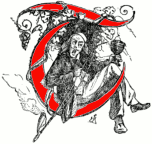
here was a fluidity of aesthetics across the arc of the Victorian illustrated book. Caricature held an audience even when the Millais school of illustration gained prominence. Punch remained the standard humor magazine throughout the long nineteenth century, giving caricature a visible position in the periodical press. Brian Maidment notes in Comedy, Caricature and the Social Order, 1820-50 that books with caricature-style illustrations were reissued well into the century and also commanded a market. Robert Seymour’s Sketches by Seymour (1836), a collection of drawings of amateur sportsmen, was reprinted into the 1880s, and George Cruikshank’s collections of sketches, Illustrations of Time (1827) and My Sketch Book (1834), were reissued, respectively, into the 1870s and 1880s. Concomitantly, on both sides of the Atlantic, caricature-style illustrations that were essential to the success of Dickens’s serial fiction were reprinted in the 1870s, the same decade that Chapman and Hall produced the Household Edition (1871-79) with Fred Barnard as lead illustrator. Barnard’s and James Mahoney’s illustrations for the Household Edition of, respectively, David Copperfield and Oliver Twist (among the first works adapted in this 22-volume series) demonstrate how Sixties artists fleshed out inventive caricature designs from the 1830s and 1840s to suit popular taste. In Barnard’s drawings for David Copperfield, there is “just enough resemblance to the figures created by H. K. Browne to save you a shock” (Dalziel 337), according to the Dalziel Brothers, the leading Victorian engravers who helped select illustrators for the Household Edition. Re-illustrating Oliver Twist for the Household Edition, Mahoney recalls Cruikshank’s theatrical staging of Oliver Asking for More and the look of many of the characters, particularly Oliver and Fagin, but he reshaped them more soberly and arguably less forcefully.
In 1890—a scant five years before Pennell declared that “among artists and people of any artistic appreciation, . . . the works of ‘Phiz,’ Cruikshank, Doyle, and even many of Leech’s designs are simply rubbish”— George Du Maurier championed the caricaturists who first illustrated Dickens. He advances in “The Illustrating of Books from the Serious Artist’s Point of View—1” (1890): “And, indeed, what does not the great Dickens himself owe to Cruikshank and Hablôt Browne, those two delightful etchers who understood and interpreted him so well!” (351). Du Maurier, a talented Sixties artist who illustrated the works of Elizabeth Gaskell and Thomas Hardy, returns his late Victorian readers’ gaze to the aesthetics of Cruikshank and Phiz, whose Pickwick illustrations gave Dickens celebrity status. Du Maurier was an inheritor of two traditions. An illustrator of the Millais school, Du Maurier reengages the caricature style associated with Cruikshank while he also continues the Sixties representational style of illustration. He incorporated theatricality and a persistent racialized depiction of the Jew from the caricature tradition into his author-illustrated fiction published in the US market in Harper’s. Du Maurier’s best-known Trilby (1894) sparked a media frenzy of Picwickian magnitude. The tale is about a menacing Jewish musical genius named Svengali, who hypnotizes Trilby O’Ferrall, a French-Irish laundress and artist’s model; under Svengali’s control, Trilby becomes an opera virtuoso, all for Svengali’s profit. Like many serials illustrated by the caricaturists, Trilby was easily adapted to the nineteenth-century stage in part owing to its most dramatic character, Svengali. Whether Svengali is reaching for piano keys in A Voice He Didn’t Understand, inspecting Trilby’s throat in “Himmel! The Roof of Your Mouth” (73), playing a musical instrument in The Flexible Flageolet (31), or simply folding his arms in All as it Used to Be (133), he exudes a theatrical intensity akin to the villains of melodrama.



Left: A Voice He Didn’t Understand. Middle: ‘Himmel! The Roof of Your Mouth’. Right: The Flexible Flageolet. [Click on images to enlarge them.]
Svengali’s hypnotic powers emerge to theatrical effect in a full-page engraving entitled “Et Maintenant Dors, Ma Mignonne!” This plate captures Svengali in the process of mesmerizing tone-deaf, tuneless Trilby O’Ferrall, who performs in all the great European cities, but wakes with no recollection of her virtuoso performances. This illustration features Marta, Svengali’s aunt, who looks after Trilby and places the diva’s crown on her head; Trilby dressed up as the opera diva called La Svengali; and Svengali, kneeling before Trilby, inducing a trance. Named La Svengali, Trilby becomes an extension of her master. Trilby looks arrestingly beautiful even in her mesmeric state, and her shapeliness is visible through her low-cut, fitted gown. But the caricatured figure of Svengali with a prominent Semitic nose commands the viewer’s attention. Svengali’s demonic eyes and dark hair mark him a demon while his pointed left ear accentuates his resemblance to a devil.


Left: “Et Maintenant Dors, Ma Mignonne!”. Right: An Incubus. [Click on images to enlarge them.]
In making Svengali a Jew and a devil, Du Maurier is reengaging a racialized depiction of the Jew prominent in Oliver Twist. In Part First, Du Maurier describes Svengali as a character “of Jewish aspect, well-featured but sinister” (T 11) with “bold, brilliant black eyes, with long heavy lids” and “a beard of burnt-up black which grew almost from his under eyelids” (12). Over the course of the novel, Du Maurier calls Svengali a “demon,” “an incubus,” a “black spider-cat,” and a “magician” (136, 137, 108, 452); likewise, he draws Svengali in a manner that accentuates his dark and diabolical nature.
An Incubus (T 137) is arguably the most darkly comic depiction of Svengali. The plate’s title derives from a quote where Trilby perceives Svengali is “a dread, powerful demon, who . . . oppressed and weighed on her like an incubus” (136–37)—a demon who preys upon women in the night. This small but powerful vignette recalls the caricature heads of the Caracci brothers although Svengali has a human head and a spider’s body. Svengali is part human, part arachnid, and part demon. Blackness, a color long associated with darkness and witchcraft, extends from his spidery legs to his deadly eyes, caricatured Semitic nose, and thick wild hair, fashioned to suggest a Jew’s devil’s horns.
Caricature can be piercing as in the desperate look of Cruikshank’s Fagin contemplating his death by hanging in Fagin in the Condemned Cell for Oliver Twist—a racialized depiction which penetrates the late-nineteenth-century work of Du Maurier in Trilby. Caricature can be hilarious as we witness in Phiz’s Mr. Pickwick Slides from The Pickwick Papers, showing plump Samuel Pickwick sliding on the ice and almost splitting open his breeches to the amusement of the onlookers, cuing us to laugh with them. And caricature can be beautiful and comical as illustrated in John Leech’s Mr. Jorrocks’s Hunt (loq)—‘Come hup! I say—You ugly Beast’” for Robert Smith Surtees’s Handley Cross; or, Mr. Jorrocks’s Hunt (1854); in this color plate, Leech combines a verdant landscape, a majestic horse, racing hounds, and a plump Pickwick-like Jorrocks just before he falls into a ditch to the amusement of the hunters and onlookers. In these plates and other original caricature-style illustrations, increasingly available to the public through digitized online editions, lies the still powerful achievement of the Victorian caricaturist artist.
Bibliography
Dalziel, George, and Edward Dalziel. The Brothers Dalziel: A Record of Fifty Years Work in Conjunction with Many of the Most Distinguished Artists of the Period 1840–1890. Methuen and Co., 1901.
Dickens, Charles. A Christmas Carol (1843). Illus. John Leech. Introd. G. K. Chesterton. Charles E. Lauriat Co., n.d.
____. David Copperfield (1850). Ed. Jerome H. Buckley. Illus. Hablot Knight Browne. Norton, 1990.
____. Oliver Twist (1838). Ed. Kathleen Tillotson. Illus. George Cruikshank. Oxford UP, 1982.
Du Maurier, George. “The Illustrating of Books from the Serious Artist’s Point of View.” Magazine of Art. (Aug.–Sept. 1890): 1: 349–53 [text in the Victorian Web; 2: 371–75.
_____. Trilby. 1894. Illus. by the author. Harper and Brothers Publishers, 1894.
Golden, Catherine J. Serials to Graphic Novels: The Evolution of the Victorian Illustrated Book. University Press of Florida, 2017.
Gombrich, E. H., and E. Kris. Caricature. Penguin Books Ltd., 1940.
Hill, Jonathan E. “Cruikshank, Ainsworth, and Tableau Illustration.” Victorian Studies 23.4 (Summer 1980): 429–59.
Jackson, Arlene M. Illustration and the Novels of Thomas Hardy. Rowman and Littlefield, 1981.
James, Henry. A Small Boy and Others. 1913. Scribner, 1914.
Pennell, Joseph. Modern Illustration. Bell, 1895.
Reid, Forrest. Illustrators of the Eighteen Sixties: An Illustrated Survey of the Work of 58 British Artists (1928). Dover Books, 1975.
Victoria, Queen. “Diaries 1838–9.” In Dickens: The Critical Heritage. Ed. Philip Collins. Routledge and Kegan Paul, 1971. 44.
White, Gleeson. English Illustration, ‘The Sixties’: 1855–70 (1897). Kingsmead Reprints, 1970.
Last modified 23 June 2019